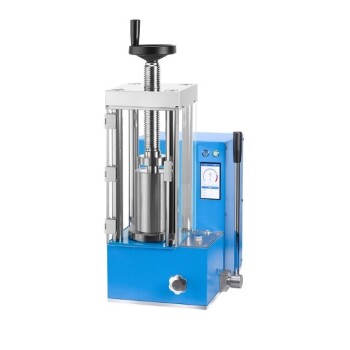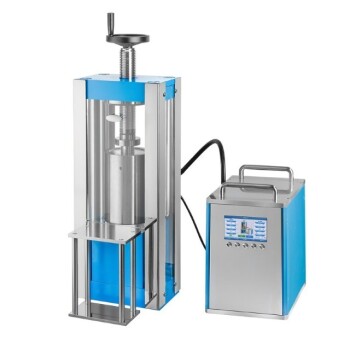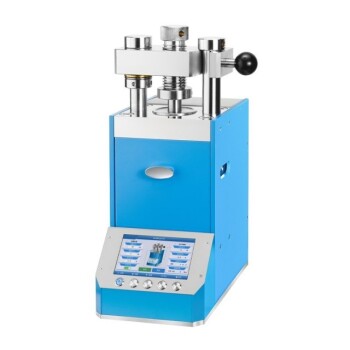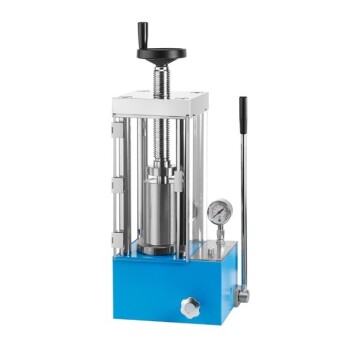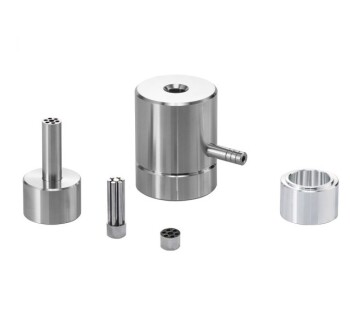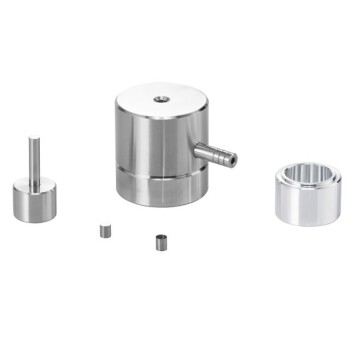In the alumina industry, Cold Isostatic Pressing (CIP) is primarily used to manufacture high-performance ceramic components like spark plug insulators. This process takes fine alumina powder and uniformly compacts it into a dense, solid "green" part that has the complex shape of the final product. The uniform pressure is the key to creating a component with a consistent microstructure, which is essential for its function as a high-voltage electrical insulator in demanding engine environments.
The true value of CIP for alumina lies in its ability to apply uniform, all-around pressure to create a dense, defect-free component before final firing. This initial uniformity is critical for achieving predictable shrinkage during sintering, ensuring the final ceramic part meets strict performance and dimensional requirements.
Why CIP is the Standard for High-Performance Alumina
Cold Isostatic Pressing is not just about shaping a part; it's about building in the material properties required for extreme applications. Its advantages directly address the challenges of manufacturing intricate and reliable ceramic components.
Achieving Uniform Density
Unlike traditional uniaxial pressing, which presses from only one or two directions and can create density variations, CIP submerges the part in a fluid and pressurizes it from all sides.
This isostatic pressure compacts the alumina powder evenly throughout the entire volume. The result is a "green body" with homogenous density, free from the internal weak spots or voids that could cause failure under thermal or electrical stress.
Enabling Complex Geometries
Spark plug insulators have intricate features, including internal bores and external ribs, that are difficult to form using rigid metal dies.
CIP uses a flexible, elastic mold. The alumina powder is placed inside this mold, which is then pressurized. The mold's flexibility allows it to form these complex shapes accurately while still transmitting pressure uniformly.
Ensuring High Green Strength
The term "green strength" refers to the mechanical strength of the part after pressing but before it has been fired (sintered).
CIP produces parts with significant green strength. This allows the delicate, pre-sintered insulator to be safely handled, transported, and even machined before the final, high-temperature firing stage, reducing the risk of costly damage and production waste.
The Foundation for Predictable Sintering
The final step in creating the ceramic part is sintering, where the green body is heated to fuse the alumina particles into a hard, dense solid. During this process, the part shrinks.
Because the CIP'd green body has a highly uniform density, its shrinkage during sintering is extremely consistent and predictable. This minimizes distortion, internal stresses, and cracking, ensuring the final product has the precise dimensions and integrity required.
Understanding the Trade-offs
While CIP is a powerful technology, it is essential to understand its specific role and limitations within the broader manufacturing landscape.
Initial Dimensional Tolerance
The flexible molds used in CIP do not offer the same rigid dimensional precision as the hardened steel dies of a uniaxial press. The initial "green" part may have slightly looser tolerances.
However, this is offset by the highly predictable shrinkage during sintering. The final sintered part is often more dimensionally consistent than one made with other methods that introduce density gradients.
Not Ideal for All Production Scales
For very simple, small shapes produced in extremely high volumes (like small discs or blocks), traditional uniaxial die pressing can be faster and more cost-effective.
CIP's advantages become most apparent when dealing with larger parts, complex geometries, or when the cost of a single defect or failure in the final application is very high.
How to Apply This to Your Project
When deciding on a consolidation method for a ceramic component, your end goal should dictate the process.
- If your primary focus is producing complex, high-integrity ceramic parts: CIP is the ideal method for creating a uniform green body that minimizes defects and ensures predictable results after sintering.
- If your primary focus is high-volume production of simple shapes: Traditional uniaxial pressing may offer a more cost-effective and faster alternative, provided density variation is not a critical concern.
- If your primary focus is achieving the absolute maximum density and eliminating all porosity: CIP should be viewed as a critical precursor to a final sintering or Hot Isostatic Pressing (HIP) step.
Ultimately, leveraging CIP for alumina is about controlling the material's microstructure from the very first step to guarantee the performance of the final component.
Summary Table:
| Aspect | Key Details |
|---|---|
| Primary Use | Manufacture high-performance ceramic components (e.g., spark plug insulators) |
| Process | Applies uniform, all-around pressure to compact alumina powder into dense green parts |
| Key Advantages | Uniform density, complex geometries, high green strength, predictable sintering |
| Limitations | Looser initial tolerances, less cost-effective for simple, high-volume parts |
| Ideal For | Complex shapes, high-integrity applications where defect minimization is critical |
Ready to elevate your ceramic manufacturing with precise, reliable pressing solutions? KINTEK specializes in lab press machines, including automatic lab presses, isostatic presses, and heated lab presses, tailored for laboratory needs. Our expertise in Cold Isostatic Pressing (CIP) can help you achieve uniform density, reduce defects, and ensure predictable sintering for high-performance alumina components. Contact us today to discuss how our solutions can optimize your production process and deliver superior results!
Visual Guide

Related Products
- Electric Lab Cold Isostatic Press CIP Machine
- Electric Split Lab Cold Isostatic Pressing CIP Machine
- Automatic Lab Cold Isostatic Pressing CIP Machine
- Manual Cold Isostatic Pressing CIP Machine Pellet Press
- Special Shape Lab Press Mold for Laboratory Applications
People Also Ask
- What is the historical background of isostatic pressing? Discover Its Evolution and Key Benefits
- What industries benefit from Cold Isostatic Pressing technology? Ensure Reliability in Aerospace, Medical, and More
- What are the advantages of Cold Isostatic Pressing for ceramic production? Achieve Uniform Density and Complex Shapes
- What are some examples of applications for cold isostatic pressing? Boost Your Material Performance with Uniform Compaction
- What are the advantages of uniform density and structural integrity in CIP? Achieve Superior Performance and Reliability
